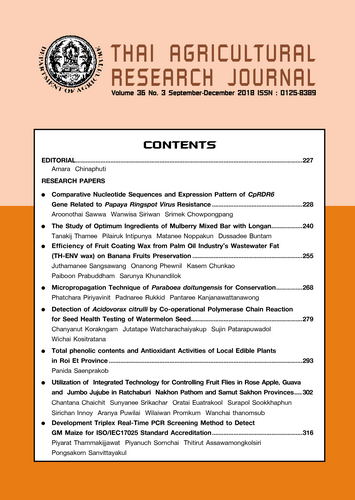Comparative Nucleotide Sequences and Expression Pattern of CpRDR6Gene Related to Papaya Ringspot Virus Resistance
DOI:
https://doi.org/10.14456/thaidoa-agres.2018.18Keywords:
Papaya, PRSV, RNA-dependent RNA polymerases 6, gene expressionAbstract
Papaya (Carica papaya L.) is an economically important fruit crop in Thailand. Its production is facing with a serious problem of papaya ring spot disease outbreak caused by Papaya Ring Spot Virus or PRSV. Several previous reports revealed that RDR6 gene were involved in RNA silencing and was related to plant viral defense mechanisms. The objectives of this experiment were to compare CpRDR6 nucleotide sequences in three papaya varieties, Khak-Dam, Florida and Khon-Kean including the expression levels in Khak-Dam (susceptible) and Florida (resistance) when infected by PRSV. The comparison of nucleotide sequences showed the partial sequence was 1,125 bp, located in a part of RDR6 protein superfamily in the first exon region. There were differences in one position at 292 where Cytosine (C) was presented in Florida, while in Khak-Dam variety it was Adinine (A) and Khon-Khan 80 both Cytosine (C) and Adinine (A) were found. The measuring results of CpRDR6 gene expression levels revealed that the highest expression level were detected at 5 and 9 days after inoculation in Khak-Dam and Florida respectively. The development of symptoms appeared as chlorosis of leaf vains at 7 days in Khak-Dam and 9 days in Florida . The level of CpRDR6 gene expression in susceptible variety was higher than that of the resistance variety.
Downloads
Published
How to Cite
Issue
Section
License

This work is licensed under a Creative Commons Attribution-NonCommercial-NoDerivatives 4.0 International License.
Thai Agricultural Research Journal



